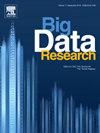Hourglass pattern matching for deep aware neural network text recommendation model
IF 4.2
3区 计算机科学
Q2 COMPUTER SCIENCE, ARTIFICIAL INTELLIGENCE
引用次数: 0
Abstract
In recent years, with the rapid development of deep learning, big data mining, and natural language processing (NLP) technologies, the application of NLP in the field of recommendation systems has attracted significant attention. However, current text recommendation systems still face challenges in handling word distribution assumptions, preprocessing design, network inference models, and text perception technologies. Traditional RNN neural network layers often encounter issues such as gradient explosion or vanishing gradients, which hinder their ability to effectively handle long-term dependencies and reverse text inference among long texts. Therefore, this paper proposes a new type of depth-aware neural network recommendation model (Hourglass Deep-aware neural network Recommendation Model, HDARM), whose structure presents an hourglass shape. This model consists of three parts: The top of the hourglass uses Word Embedding for input through Fine-tune Bert to process text embeddings as word distribution assumptions, followed by utilizing bidirectional LSTM to integrate Transformer models for learning critical information. The middle of the hourglass retains key features of network outputs through CNN layers, which are combined with pooling layers to extract and enhance critical information from user text. The bottom of the hourglass avoids a decline in generalization performance through deep neural network layers. Finally, the model performs pattern matching between text vectors and word embeddings, recommending texts based on their relevance. In experiments, this model improved metrics like MSE and NDCG@10 by 8.74 % and 10.89 % respectively compared to the optimal baseline model.

沙漏模式匹配的深度感知神经网络文本推荐模型
近年来,随着深度学习、大数据挖掘和自然语言处理(NLP)技术的快速发展,自然语言处理在推荐系统领域的应用备受关注。然而,当前的文本推荐系统在处理词分布假设、预处理设计、网络推理模型和文本感知技术等方面仍然面临挑战。传统的RNN神经网络层经常遇到梯度爆炸或梯度消失等问题,阻碍了其有效处理长文本间的长期依赖关系和反向文本推理的能力。因此,本文提出了一种新型的深度感知神经网络推荐模型(沙漏深度感知神经网络推荐模型,HDARM),其结构呈沙漏形状。该模型由三部分组成:沙漏的顶部使用Word Embedding作为输入,通过微调Bert处理文本嵌入作为单词分布假设,然后使用双向LSTM集成Transformer模型以学习关键信息。沙漏的中间部分通过CNN层保留网络输出的关键特征,并结合池化层从用户文本中提取和增强关键信息。沙漏的底部通过深度神经网络层避免了泛化性能的下降。最后,该模型在文本向量和词嵌入之间进行模式匹配,根据它们的相关性推荐文本。在实验中,与最优基线模型相比,该模型将MSE和NDCG@10等指标分别提高了8.74%和10.89%。
本文章由计算机程序翻译,如有差异,请以英文原文为准。
求助全文
约1分钟内获得全文
求助全文
来源期刊

Big Data Research
Computer Science-Computer Science Applications
CiteScore
8.40
自引率
3.00%
发文量
0
期刊介绍:
The journal aims to promote and communicate advances in big data research by providing a fast and high quality forum for researchers, practitioners and policy makers from the very many different communities working on, and with, this topic.
The journal will accept papers on foundational aspects in dealing with big data, as well as papers on specific Platforms and Technologies used to deal with big data. To promote Data Science and interdisciplinary collaboration between fields, and to showcase the benefits of data driven research, papers demonstrating applications of big data in domains as diverse as Geoscience, Social Web, Finance, e-Commerce, Health Care, Environment and Climate, Physics and Astronomy, Chemistry, life sciences and drug discovery, digital libraries and scientific publications, security and government will also be considered. Occasionally the journal may publish whitepapers on policies, standards and best practices.
 求助内容:
求助内容: 应助结果提醒方式:
应助结果提醒方式:


